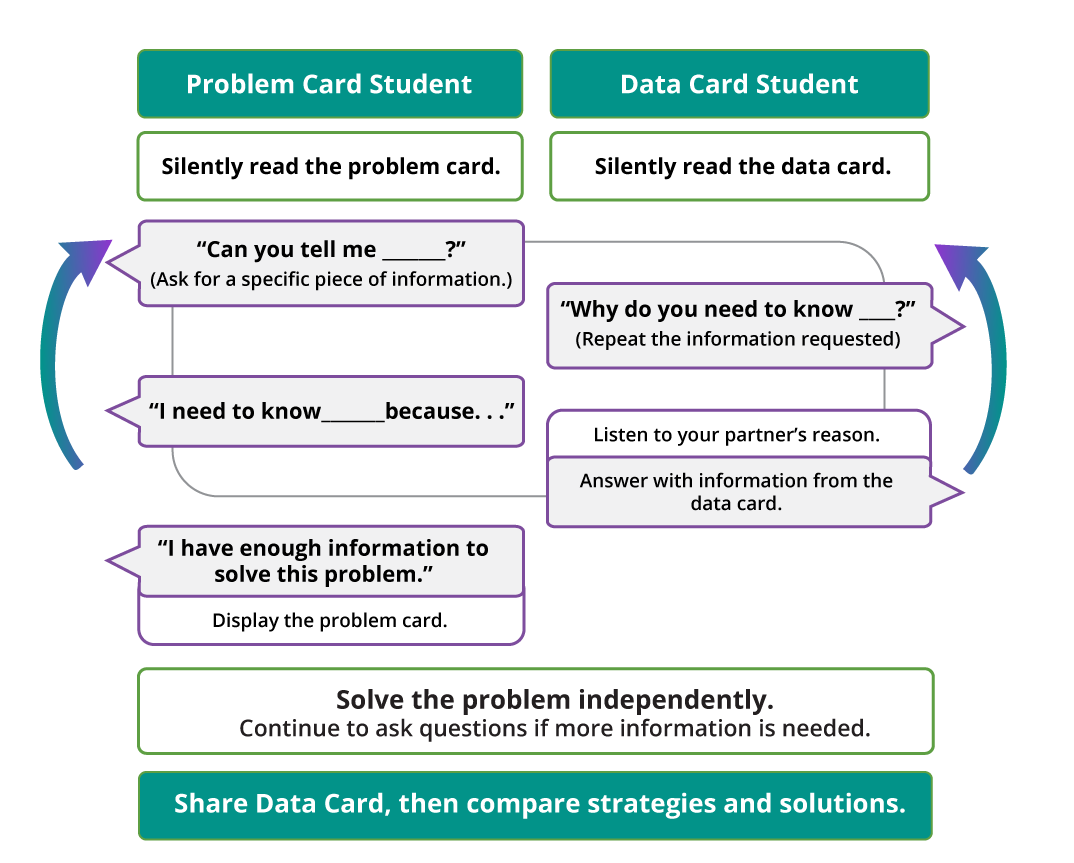Lesson 14
Area Situations
Warm-up: Number Talk: Multiply Fractions (10 minutes)
Narrative
This Number Talk encourages students to think about the relationship between division and fractions and the order of operations in order to strategically multiply whole numbers by fractions. The strategies elicited here will be helpful later in the lesson when students find the missing value in multiplication equations for a whole number and a fraction.
To use the properties of operations, students need to look for and make use of structure (MP7). In explaining strategies, students need to be precise in their word choice and use of language (MP6).
Launch
- Display one problem.
- “Give me a signal when you have an answer and can explain how you got it.”
- 1 minute: quiet think time
Activity
- Record answers and strategy.
- Keep problems and work displayed.
- Repeat with each problem.
Student Facing
Find the value of each expression mentally.
- \( 3 \times (10 \div 2)\)
- \(\frac{3}{2} \times 10\)
- \(\left(\frac{14}{7}\right) \times 10\)
- \(14 \times\frac{10}{7}\)
Student Response
For access, consult one of our IM Certified Partners.
Activity Synthesis
- “How can rearranging the numbers and operations help find the value of the last expression?” (I know that \(\frac{14}{7}\) is 2 so finding this first and then multiplying by 10 is easier than trying to work with the fraction \(\frac{10}{7}\).)
Activity 1: Info Gap: Area (20 minutes)
Narrative
This Info Gap activity gives students an opportunity to determine and request the information needed to solve multi-step problems involving multiplication of a whole number by a fraction. In each case, there are multiple ways to solve the problem but the information card does not have the one piece of information—the missing side length—that the student with the problem card could use to find the area. The cards are designed this way to encourage the students to discuss and communicate further.
The Info Gap structure requires students to make sense of problems by determining what information is necessary, and then to ask for information they need to solve it. This may take several rounds of discussion if their first requests do not yield the information they need (MP1). Moreover, they are prompted by their partner to explain why they need each piece of information so they need to articulate their strategy and reasoning. The Info Gap structure also allows them to refine the language they use and ask increasingly more precise questions until they get the information they need (MP6).
Required Materials
Materials to Copy
- Info Gap: Area
Required Preparation
Launch
- Groups of 2
- Distribute a problem card to one student and a data card to the other student.
Activity
- Explain the Info Gap structure, and consider demonstrating the protocol if students are unfamiliar with it.
- 10 minutes: partner work time
- After you review their work on the first problem, give them the cards for a second problem and instruct them to switch roles.
Student Facing
Your teacher will give you either a problem card or a data card. Do not show or read your card to your partner.

Pause here so your teacher can review your work. Ask your teacher for a new set of cards and repeat the activity, trading roles with your partner.
Student Response
For access, consult one of our IM Certified Partners.
Activity Synthesis
- Select 2–3 students to share the correct answers and discuss the process of solving the problems.
- “What questions did you ask to get the information you needed to solve the problems?” (I was missing just one piece of information—the width of the paper towel or the length of the corn field. I asked for that but my partner did not have it. I was stuck and then my partner said they had information comparing the length and width. I was able to use that to find the width or length and then the area.)
Activity 2: Fill in the Blank [OPTIONAL] (15 minutes)
Narrative
The purpose of this activity is for students to find the missing value in equations involving a whole number and a fraction. They find missing factors or products to make equations true. Many of the problems encourage students to think in steps, interpreting a fraction \(\frac{a}{b}\) in terms of division by the denominator and multiplication by the numerator.
Supports accessibility for: Conceptual Processing, Memory
Launch
- Groups of 2
Activity
- 5–8 minutes: independent work time
- 1–2 minutes: partner discussion
- Monitor for:
- partners who use different strategies.
- students who are challenged but persevere and arrive at a viable solution.
Student Facing
Fill in the blanks to make each equation true. Be prepared to explain your reasoning.
- \(\frac{1}{3} \times 18 =\underline{\hspace{0.7cm}}\)
- \(\frac{7}{9} \times \underline{\hspace{0.7cm}} = \frac{21}{9}\)
- \(\frac{1}{15} \times \underline{\hspace{0.7cm}} = 2\)
- \(9 \times 6 \frac{2}{3} = \underline{\hspace{0.7cm}} \)
- \(14 \frac {99}{100} \times 10 = \underline{\hspace{0.7cm}} \)
- \(7 \frac {3}{5} \times 6 = \underline{\hspace{0.7cm}}\)
- \(4 \times 6 \frac {9}{10} = \underline{\hspace{0.7cm}}\)
Student Response
For access, consult one of our IM Certified Partners.
Advancing Student Thinking
If students do not get the correct solution for the missing factor problems, ask “How would you represent this expression with a diagram?”
Activity Synthesis
- Ask previously selected students to share their responses.
- “What was different about you and your partner's strategies?”
- “Which problem did you find most challenging and why?”
- “Which problem made the most sense to you and why?”
Lesson Synthesis
Lesson Synthesis
“Today we multiplied whole numbers by fractions greater than one in different forms.”
“We have learned a lot about multiplying a whole number by a fraction or mixed number. What have you learned? What do you still wonder?”
Consider giving students time to respond in their journals before sharing.
Cool-down: Evaluate Expressions (5 minutes)
Cool-Down
For access, consult one of our IM Certified Partners.